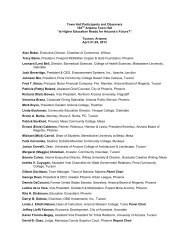Background Report - Arizona Town Hall
Background Report - Arizona Town Hall
Background Report - Arizona Town Hall
You also want an ePaper? Increase the reach of your titles
YUMPU automatically turns print PDFs into web optimized ePapers that Google loves.
financial center of the <strong>Arizona</strong> territory. Bisbee was typical of the commodity-producing<br />
towns that once defined vast areas of the American West, and this is a remarkable story to<br />
celebrate.<br />
As cultural institutions, we can be central players in the economic well-being and revitalization<br />
of our respective communities—a responsibility key to the survival of rural museums<br />
need to assume in order to survive. Mining has always been a volatile enterprise, and with the<br />
closure of most of its mines during the mid-twentieth century, Bisbee reinvented itself by<br />
capitalizing on its history, aligning itself with the growth of <strong>Arizona</strong>’s tourism industry. Today’s<br />
Bisbee prospers because of this transformation and the lively diversity of its residents, whose<br />
creative energy is rooted in a powerful blend of historic preservation and the arts.<br />
Underlying the Bisbee Mining & Historical Museum’s conceptual framework of preserving<br />
and promoting a vibrant cultural heritage is the hardrock reality of economic sustainability,<br />
both for local institutions and communities. In Bisbee, residents work together to both<br />
enhance the tourism experience, and to sustain the unique sense of place of the community.<br />
Such collaboration preserves the unique rural heritage of Bisbee, while adding to a shared<br />
sense of belonging.<br />
A Well-Kept Secret<br />
John A. Ware, Executive Director, The Amerind Foundation, Dragoon<br />
The Amerind Foundation was established in 1937 as an archaeological research institute<br />
dedicated to the advancement of knowledge about the Native Peoples of the Americas.<br />
The Amerind campus is located on a 1600 acre former cattle ranch in Texas Canyon, northern<br />
Cochise County, about sixty miles east of Tucson. Amerind’s founder, New England<br />
industrialist William Shirley Fulton, chose this location because he wanted Amerind’s<br />
research efforts to be far from the distractions of a major metropolitan area.<br />
<br />
sites in the Southwestern Borderlands, culminating in the multi-year Joint Casas Grandes<br />
Project in northern Chihuahua—one of the largest archaeological projects ever conducted in<br />
the Southwest. The nature of archaeological research and funding for basic research began<br />
to change in the 1960s and by the late 1970s it was no longer possible for small research<br />
centers to compete for scarce federal research dollars. As the discipline changed, the Amerind<br />
adapted by modifying its mission. Since 1980 the Amerind has supported the basic research<br />
of others through advanced seminars, a visiting scholar program, and professional<br />
publications. Today, the Amerind sponsors up to ten advanced seminars a year through an<br />
active collaboration with the Society for American Archaeology, the University of<br />
<strong>Arizona</strong>, <strong>Arizona</strong> State University, and other regional universities.<br />
Within a few years of its founding the Amerind established a museum and art gallery to<br />
exhibit its growing collection of art and artifacts. Open to the public only by appointment, the<br />
Amerind Museum would eventually house one of the finest private collections of American<br />
Indian art and material culture in the country, but it remained, by design, a closely kept secret<br />
during its first fifty years. In a letter to a colleague in the 1960s, long-time Amerind director<br />
168 | Chapter 16




